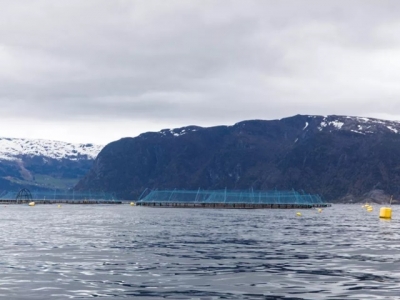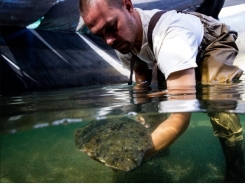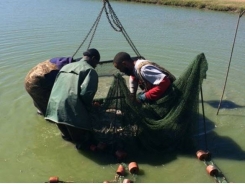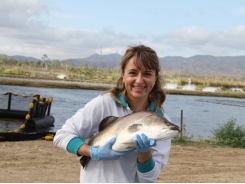Land-use efficiency study puts aquaculture on a pedestal

With mounting pressure on natural resources, NCEAS compares fish farming to terrestrial agriculture
A recent study by the National Center for Ecological Analysis and Synthesis focused on land-use implications of traditional, terrestrial meat production versus carefully planned and implemented aquaculture. Photo by James Wright.
Aquaculture is the future of food.
At least, that was the conclusion of a recent study conducted by the National Center for Ecological Analysis and Synthesis (NCEAS) and published in the Proceedings of the National Academy of Sciences of the United States of America. Focused on land-use implications of traditional, terrestrial meat production, the study found that aquaculture can, if carefully planned and implemented, meet the protein demands related to the growing global population without causing additional strain on land, water or our other natural resources.
In fact, the industry can play a major role in reducing the footprint needed to produce food in the future, creating a more sustainable food system for us all.
Who knew?
“We were motivated by the larger global considerations and challenges of the ever-growing human population and our dependency on land to produce that food,” explained lead author Halley Froehlich, a postdoctoral researcher at NCEAS, which is part of the University of California at Santa Barbara. “There is a finite amount of that resource. So, what does that mean for sustainability and larger conservation considerations?”
NCEAS researchers compared today’s land-use needs for terrestrial meat production to a potential future in which aquaculture provides the additional protein that the population will need by 2050. They found that large-scale adoption of aquaculture could save as much as 1.8 billion acres of land worldwide – an area equal to twice the size of India – freeing that land up for agriculture and other productive uses.
And we wouldn’t even need to give up meat entirely to get there.
“For land-based production, there’s a wide range of plausible futures, so how from a terrestrial perspective can we meet our needs? You can increase land efficiencies of the crops you’re growing; you can increase irrigation; you can increase the efficiencies of the terrestrial-based animals,” said Froehlich. “But nobody had thought in a broader sense how aquaculture fits into that portfolio of solutions. By no means is this the only possibility or a silver bullet for solving what’s coming down for our consumption demands, but it’s definitely part of the discussion that we should be having and that hasn’t really been had up until this point.”
A changing planet
The time to start talking about this now, Froehlich and others argue, because humans may soon run out of food, or their ability to produce it.
According to the Food and Agriculture Organization of the United Nations, food producers will need to more than double production from current levels by 2050 in order to meet new the demand for protein from the world’s growing population, which is on track to top 10 billion in that time, along with that population’s improved quality of life. But the planet is running out of arable land, which is down by roughly a third in the last 40 years due to erosion, pollution and other factors.
While there is some debate on these figures – they tend to range from an increase of 20 percent to 100 percent more food production over the next 30 years – the fact remains that current food production patterns focused on large-scale terrestrial agriculture and ranching are unsustainable.
The problem is twofold: Cattle, in particular, need space. It takes as much as two acres of land to pasture feed a cow for a year. And cows are inefficient protein producers, ingesting more than six pounds of feed and eight gallons of water for every pound of meat that they produce, a figure known as the feed conversion ratio (FCR). Chicken and pigs are a little better, at 2 and 3.5 per pound of finished product, respectively. FCRs are related to land use because one-third of the planet’s arable land is currently being used to produce crops for livestock feed, a number expected to rise as demand increases.
The aquaculture advantage
Farmed fish, on the other hand, are a vastly more efficient source of animal protein, at just 1.15 FCR for a Norwegian Atlantic salmon, 1.5 for an Australian barramundi, 1.1 for tilapia and so forth. What’s more, although aquaculture does put pressure on certain land-based crops for some feed production, such as soybean meal and soy-based additives, the relative need for them by the industry is much lower than for terrestrial-based production.
“It really comes down to the organisms being what they call poikilotherms, so they really depend on the temperature surrounding them to dictate how efficient they are,” said Froehlich. “They don’t have to work very hard to stay warm because it will be dependent on their environment, versus animals on land, which have to regulate their own temperature because they’re birds or mammals.”
Fish also live underwater, and as a result are very efficient at converting feed into biomass in comparison to animals that live on land.
“Land animals have to fight gravity, so they have thick bones and stronger muscles,” explained study co-author Dr. Ben Halpern, director of NCEAS and professor at UCSB’s Bren School of Environmental Science and Management. “That’s a whole lot of biomass needed just to stand up and walk around, and it’s stuff that can’t be eaten. So you’re putting a lot of energy into growing an infrastructure of the animal. Whereas in the ocean you don’t have to do any of that, so fish put much more of their energy from food into things that we can then eat.”
The biodiversity of aquaculture is another advantage for the industry, as species like bivalves don’t necessarily require any direct feed input at all, further reducing their land use footprint. The NCEAS study assumed a 25 percent contribution from mollusks in its figures.
Looking ahead
The researchers didn’t issue any specific guidance as part of their work, or look at the land-use implications of aquaculture facilities themselves, but their hope is that their findings will inspire others to take action.
“We don’t really know what people will want to eat in 2050 or exactly how many people will be on the planet,” said Halpern. “But we know there’ll be a lot more people and we know they’re going to want more protein in general.”
Their idea wasn’t to try to predict what the future would look like but to make a point that there are some significant land-use implications for a future where people continue to eat a lot of beef and pork and chicken versus a future where people eat more farmed seafood.
“Putting more emphasis on growth and production around aquaculture can really help alleviate some of the future pressures on land use and land conservation that come from food production,” he said.
About Author: Tim Sprinkle is a writer based in Denver, Colo. His work has appeared in Wired, Outside and many other publications, and he is the author of the 2015 book, “Screw the Valley: A Coast-to-Coast Tour of America’s New Tech Startup Culture.”
Có thể bạn quan tâm
Phần mềm

Phối trộn thức ăn chăn nuôi

Pha dung dịch thủy canh

Định mức cho tôm ăn

Phối trộn phân bón NPK

Xác định tỷ lệ tôm sống

Chuyển đổi đơn vị phân bón

Xác định công suất sục khí

Chuyển đổi đơn vị tôm

Tính diện tích nhà kính

Tính thể tích ao hồ




 Reducing digestible protein in pond production of hybrid…
Reducing digestible protein in pond production of hybrid…  Predicting parasite outbreaks in fish farms through environmental…
Predicting parasite outbreaks in fish farms through environmental…